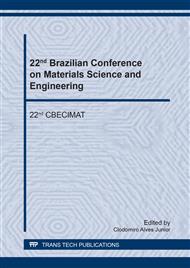p.327
p.333
p.339
p.345
p.349
p.356
p.362
p.368
p.374
Limit Strains Analysis of Advanced High Strength Steels Sheets Based on Surface Roughness Measurements
Abstract:
The limit strains of dual-phase steels DP600 and 800 were evaluated in this work with a localization model formulated in plane-stress conditions using elasto-plastic constitutive equations. In this model, a geometrical imperfection parameter is defined from the sheet nominal thickness, initial ferrite grain size and average surface roughness. The proposed identification procedure provided a more physically meaning for this parameter and at best more conservative predictions in the drawing Forming Limit Curve (FLC) range of both investigated dual-phase steels. Nevertheless, the corresponding limit strains in the biaxial stretching region are underestimated with the present theoretical model. Thus, more detailed anisotropic yield function and hardening descriptions must be implemented to improve the accuracy of the FLC prediction of advanced high strength steels.
Info:
Periodical:
Pages:
349-355
Citation:
Online since:
September 2018
Price:
Сopyright:
© 2018 Trans Tech Publications Ltd. All Rights Reserved
Share:
Citation:


